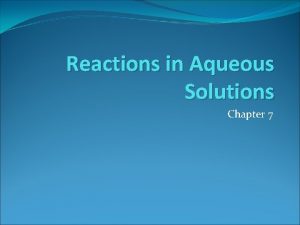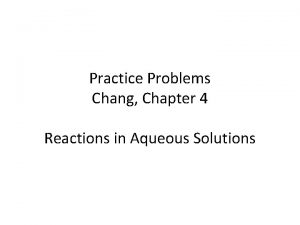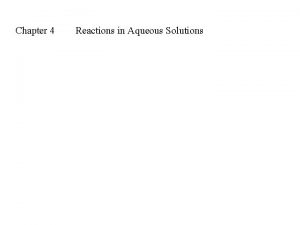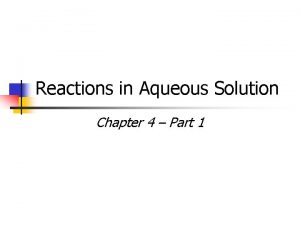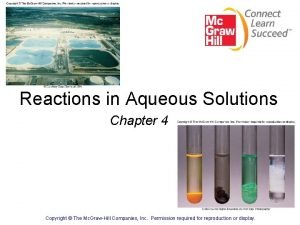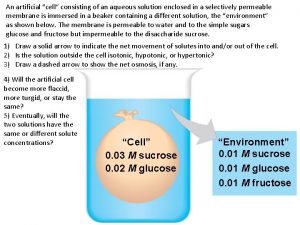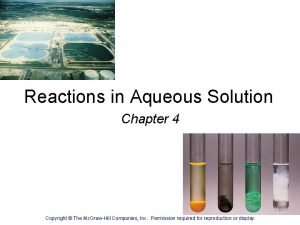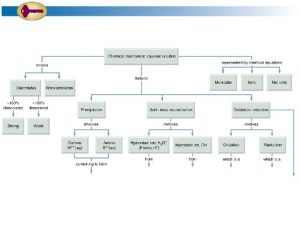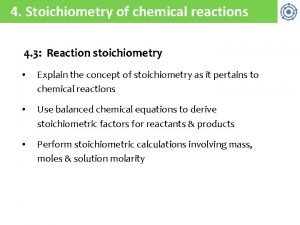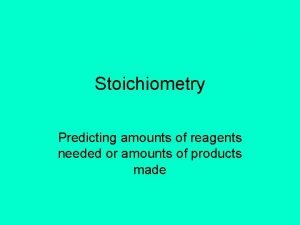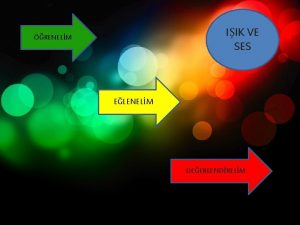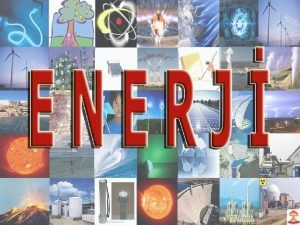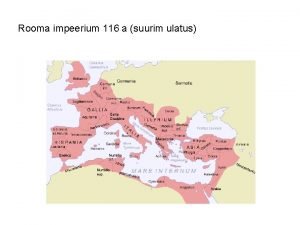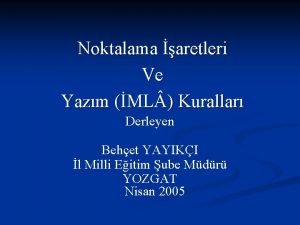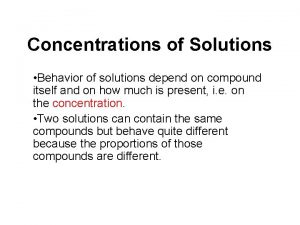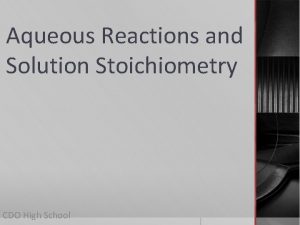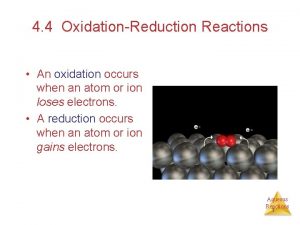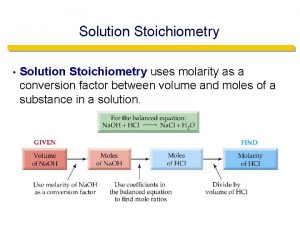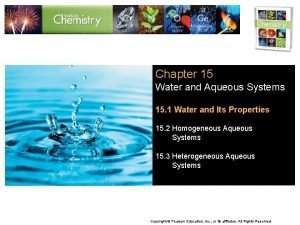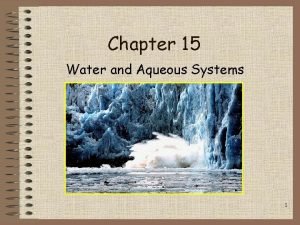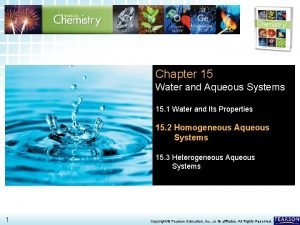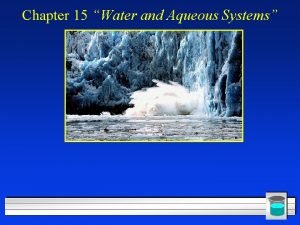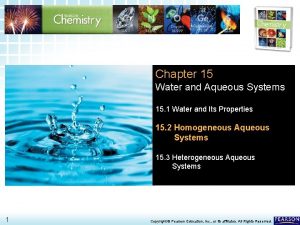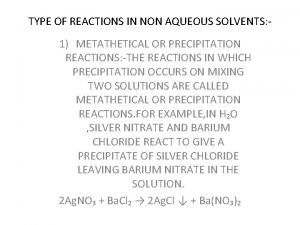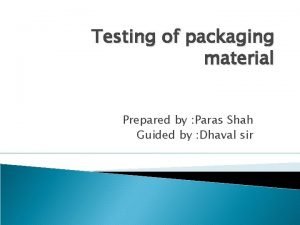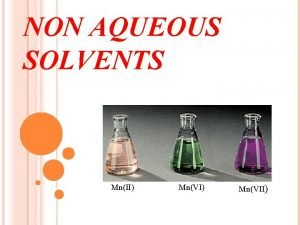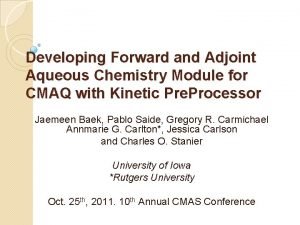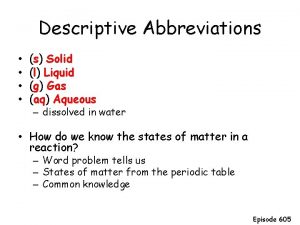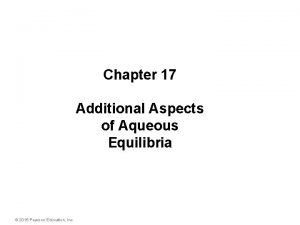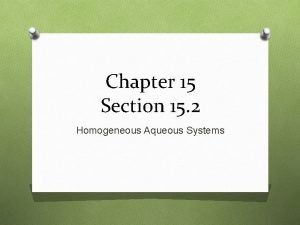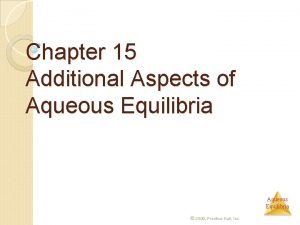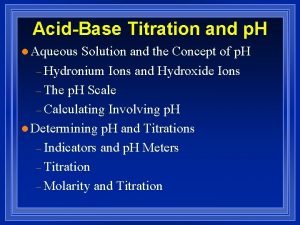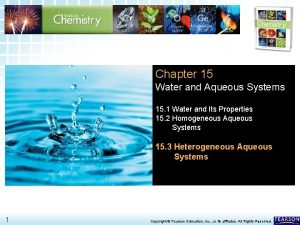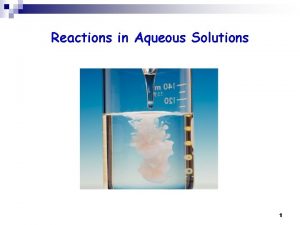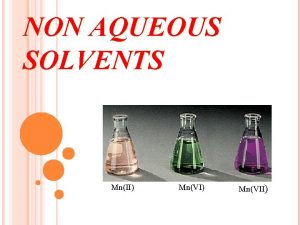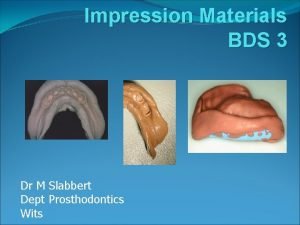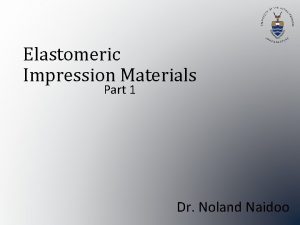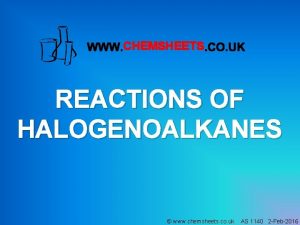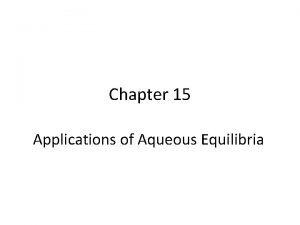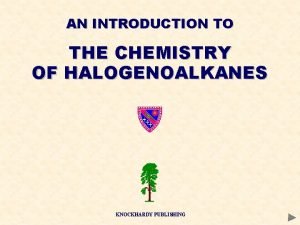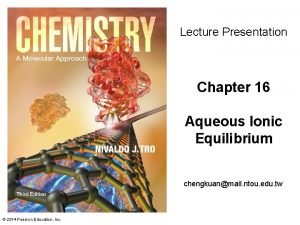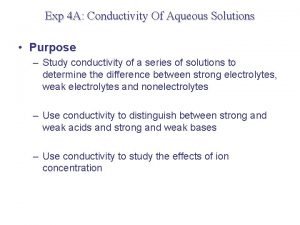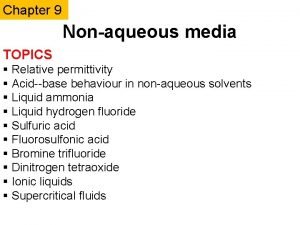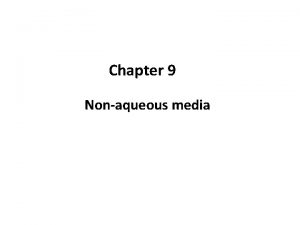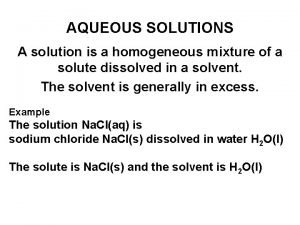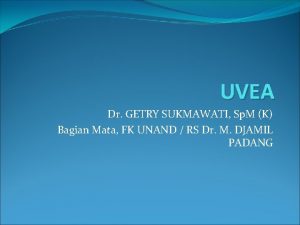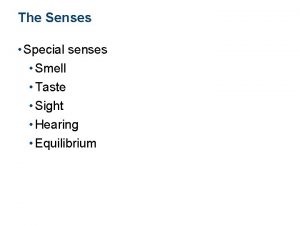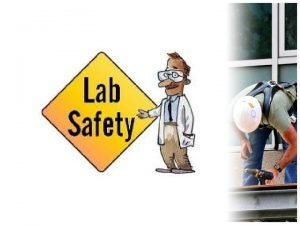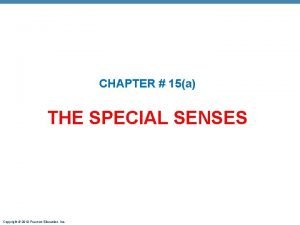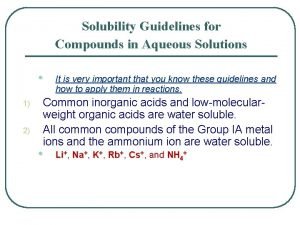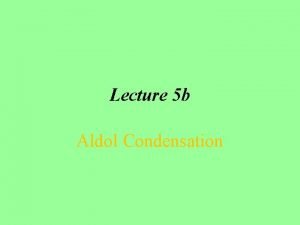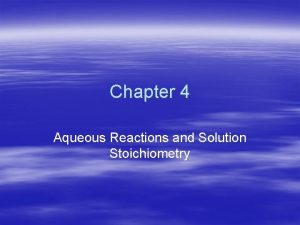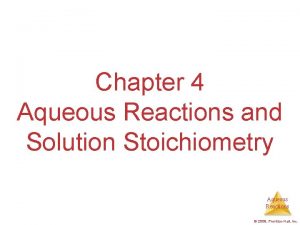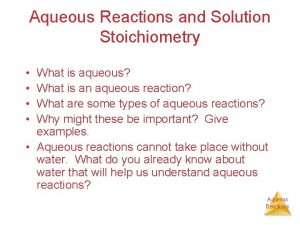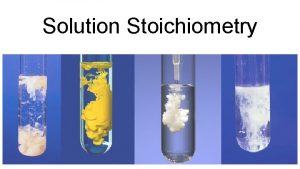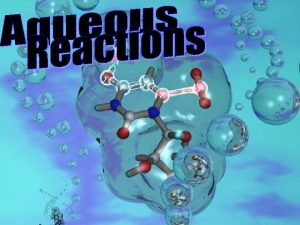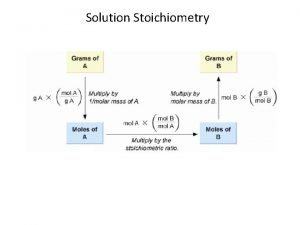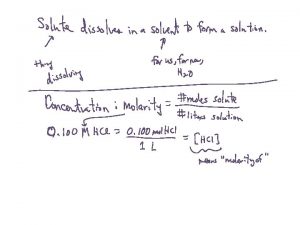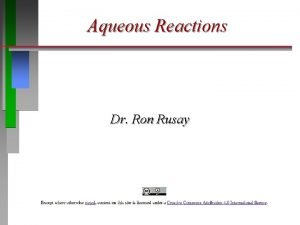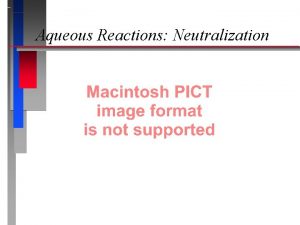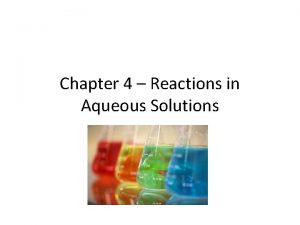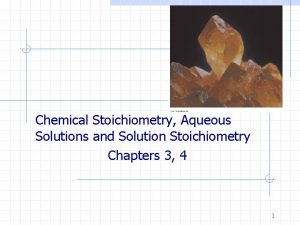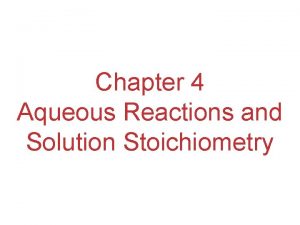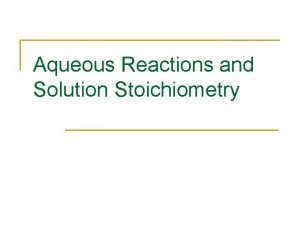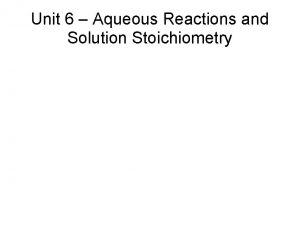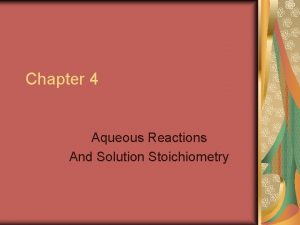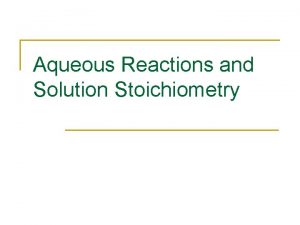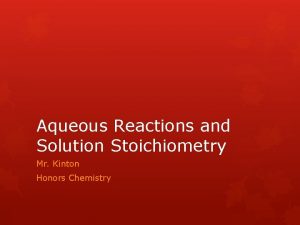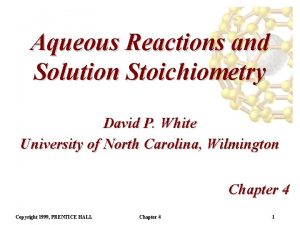Aqueous Reactions and Solution Stoichiometry YAY More Stoichiometry






















































































- Slides: 86

Aqueous Reactions and Solution Stoichiometry YAY! More Stoichiometry! 1

Solutions: Homogeneous mixtures of two or more pure substances. The solvent is present in greatest abundance. All other substances are solutes. 2

Table 4. 1 Guess what else you must memorize! 3

Classify the following ionic compounds as soluble or insoluble in water: (a) sodium carbonate (Na 2 CO 3), (b) lead sulfate (Pb. SO 4). Classify the following compounds as soluble or insoluble in water: (a) cobalt(II) hydroxide, (b) barium nitrate, (c) ammonium phosphate. 4

Dissociation When an ionic substance dissolves in water, the solvent pulls the individual ions from the crystal and solvates them. This process is called dissociation. 5

Electrolytes Substances that dissociate into ions when dissolved in water. A nonelectrolyte may dissolve in water, but it does not dissociate into ions when it does so. 6

Electrolytes and Nonelectrolytes Soluble ionic compounds tend to be electrolytes. 7

Electrolytes and Nonelectrolytes Molecular compounds tend to be nonelectrolytes, except for acids and bases. 8

Electrolytes A strong electrolyte dissociates completely when dissolved in water. A weak electrolyte only dissociates partially when dissolved in water. 9

Strong Electrolytes Are… Strong acids • Strong bases • Soluble ionic salts 10

Strong Electrolytes Are… Strong acids • Strong bases • Soluble ionic salts 11

Strong Electrolytes Are… Strong acids • Strong bases • Soluble ionic salts 12

Identifying Strong, Weak, and Nonelectrolytes Classify each of the following dissolved substances as a strong electrolyte, weak electrolyte, or nonelectrolyte: Ca. Cl 2 , HNO 3, C 2 H 5 OH (ethanol), HCHO 2 (formic acid), KOH. 13

Consider solutions in which 0. 1 mol of each of the following compounds is dissolved in 1 L of water: Ca(NO 3)2 (calcium nitrate), C 6 H 12 O 6 (glucose), Na. C 2 H 3 O 2 (sodium acetate), and HC 2 H 3 O 2 (acetic acid). Rank the solutions in order of increasing electrical conductivity, based on the fact that the greater the number of ions in solution, the greater the conductivity. 14

Precipitation Reactions When one mixes ions that form compounds that are insoluble (as could be predicted by the solubility guidelines), a precipitate is formed. 15

Metathesis (Exchange) Reactions Metathesis comes from a Greek word that means “to transpose” Formerly called double replacement reactions Ag. NO 3 (aq) + KCl (aq) Ag. Cl (s) + KNO 3 (aq) 16

Metathesis (Exchange) Reactions It appears the ions in the reactant compounds exchange, or transpose, ions Ag. NO 3 (aq) + KCl (aq) Ag. Cl (s) + KNO 3 (aq) 17

Metathesis (Exchange) Reactions Ag. NO 3 (aq) + KCl (aq) Ag. Cl (s) + KNO 3 (aq) 18

SAMPLE EXERCISE 4. 3 Predicting a Metathesis Reaction (a) Predict the identity of the precipitate that forms when solutions of Ba. Cl 2 and K 2 SO 4 are mixed. (b) Write the balanced chemical equation for the reaction. PRACTICE EXERCISE (a) What compound precipitates when solutions of Fe 2(SO 4)3 and Li. OH are mixed? (b) Write a balanced equation for the reaction. (c) Will a precipitate form when solutions of Ba(NO 3)2 and KOH are mixed? 19

Solution Chemistry It is helpful to pay attention to exactly what species are present in a reaction mixture (i. e. , solid, liquid, gas, aqueous solution). If we are to understand reactivity, we must be aware of just what is changing during the course of a reaction. 20

Molecular Equation The molecular equation lists the reactants and products in their molecular form. Ag. NO 3 (aq) + KCl (aq) Ag. Cl (s) + KNO 3 (aq) 21

Ionic Equation In the ionic equation all strong electrolytes (strong acids, strong bases, and soluble ionic salts) are dissociated into their ions. This more accurately reflects the species that are found in the reaction mixture. Ag+ (aq) + NO 3 - (aq) + K+ (aq) + Cl- (aq) Ag. Cl (s) + K+ (aq) + NO 3 - (aq) 22

Net Ionic Equation To form the net ionic equation, cross out anything that does not change from the left side of the equation to the right. Ag+(aq) + NO 3 -(aq) + K+(aq) + Cl-(aq) Ag. Cl (s) + K+(aq) + NO 3 -(aq) 23

Net Ionic Equation To form the net ionic equation, cross out anything that does not change from the left side of the equation to the right. The only things left in the equation are those things that change (i. e. , react) during the course of the reaction. Those things that didn’t change (and were deleted from the net ionic equation) are called spectator ions. Ag+(aq) + NO 3 -(aq) + K+(aq) + Cl-(aq) Ag. Cl (s) + K+(aq) + NO 3 -(aq) 24

Net Ionic Equation The only things left in the equation are those things that change (i. e. , react) during the course of the reaction. Ag+(aq) + Cl-(aq) Ag. Cl (s) 25

Steps to Writing Net Ionic Equations 1. 2. 3. 4. Write a balanced molecular equation. Dissociate all strong electrolytes. Cross out anything that remains unchanged from the left side to the right side of the equation. Write the net ionic equation with the species that remain. 26

SAMPLE EXERCISE 4. 4 Writing a Net Ionic Equation Write the net ionic equation for the precipitation reaction that occurs when solutions of calcium chloride and sodium carbonate are mixed. 27

PRACTICE EXERCISE Write the net ionic equation for the precipitation reaction that occurs when aqueous solutions of silver nitrate and potassium phosphate are mixed. 28

Ye olde Brønsted–Lowry definition of acids & bases… acid is defined as anything that releases H 1+ ions base is defined as anything that accepts H 1+ ions. The Brønsted-Lowry concept is based on the transfer of a proton from one substance to another. i. e. an acid is a proton donor; a base is a proton acceptor. 29

Acids: Substances that increase the concentration of H+ when dissolved in water (Arrhenius). Proton donors (Brønsted–Lowry). 30

There are only seven strong acids: • • Hydrochloric (HCl) Hydrobromic (HBr) Hydroiodic (HI) Nitric (HNO 3) Sulfuric (H 2 SO 4) Chloric (HCl. O 3) Perchloric (HCl. O 4) 31

SAMPLE EXERCISE 4. 5 Comparing Acid Strengths The following diagrams represent aqueous solutions of three acids (HX, HY, and HZ) with water molecules omitted for clarity. Rank them from strongest to weakest. Solution Analyze: We are asked to rank three acids from strongest to weakest, based on schematic drawings of their solutions. Plan: We can examine the drawings to determine the relative numbers of uncharged molecular species present. The strongest acid is the one with the most H+ ions and fewest undissociated acid molecules in solution. The weakest is the one with the largest number of undissociated molecules. Solve: The order is HY > HZ > HX. HY is a strong acid because it is totally ionized (no HY molecules in solution), whereas both HX and HZ are weak acids, whose solutions consist of a mixture of molecules and ions. Because HZ contains more H+ ions and fewer molecules than HX, it is a stronger acid. 32

SAMPLE EXERCISE 4. 5 continued PRACTICE EXERCISE Imagine a diagram showing ten Na+ ions and ten OH– ions. If this solution were mixed with the one pictured on the previous page for HY, what would the diagram look like that represents the solution after any possible reaction? (H+ ions will react with OH– ions to form H 2 O. ) 33

Bases: Substances that increase the concentration of OH− when dissolved in water (Arrhenius). Proton acceptors (Brønsted–Lowry). 34

The strong bases are the soluble salts of hydroxide ion: • • Alkali metals Calcium Strontium Barium 35

Acid-Base Reactions In an acid-base reaction, the acid donates a proton (H+) to the base. 36

Neutralization Reactions Generally, when solutions of an acid and a base are combined, the products are a salt and water. HCl (aq) + Na. OH (aq) Na. Cl (aq) + H 2 O (l) 37

Neutralization Reactions When a strong acid reacts with a strong base, the net ionic equation is… HCl (aq) + Na. OH (aq) Na. Cl (aq) + H 2 O (l) H+ (aq) + Cl- (aq) + Na+ (aq) + OH-(aq) Na+ (aq) + Cl- (aq) + H 2 O (l) 38

Neutralization Reactions When a strong acid reacts with a strong base, the net ionic equation is… HCl (aq) + Na. OH (aq) Na. Cl (aq) + H 2 O (l) H+ (aq) + Cl- (aq) + Na+ (aq) + OH-(aq) Na+ (aq) + Cl- (aq) + H 2 O (l) H+ (aq) + Cl- (aq) + Na+ (aq) + OH- (aq) Na+ (aq) + Cl- (aq) + H 2 O (l) 39

Neutralization Reactions Observe the reaction between Milk of Magnesia, Mg(OH)2, and HCl. 40

SAMPLE EXERCISE 4. 7 Writing Chemical Equations for a Neutralization Reaction (a) Write a balanced molecular equation for the reaction between aqueous solutions of acetic acid (HC 2 H 3 O 2) and barium hydroxide [Ba(OH)2]. (b) Write the net ionic equation for this reaction. 41

PRACTICE EXERCISE (a) Write a balanced molecular equation for the reaction of carbonic acid (H 2 CO 3) and potassium hydroxide (KOH). (b) Write the net ionic equation for this reaction. 42

Gas-Forming Reactions These metathesis reactions do not give the product expected. The expected product decomposes to give a gaseous product (CO 2 or SO 2). Ca. CO 3 (s) + HCl (aq) Ca. Cl 2 (aq) + CO 2 (g) + H 2 O (l) Na. HCO 3 (aq) + HBr (aq) Na. Br (aq) + CO 2 (g) + H 2 O (l) Sr. SO 3 (s) + 2 HI (aq) Sr. I 2 (aq) + SO 2 (g) + H 2 O (l) 43

Gas-Forming Reactions This reaction gives the predicted product, but you had better carry it out in the hood, or you will be very unpopular! Just as in the previous examples, a gas is formed as a product of this reaction: Na 2 S (aq) + H 2 SO 4 (aq) Na 2 SO 4 (aq) + H 2 S (g) 44

Oxidation-Reduction Reactions An oxidation occurs when an atom or ion loses electrons. A reduction occurs when an atom or ion gains electrons. 45

Oxidation-Reduction Reactions One cannot occur without the other. 46

Oxidation Numbers To determine if an oxidation-reduction reaction has occurred, we assign an oxidation number to each element in a neutral compound or charged entity. 47

Rules for Assigning Oxidation Numbers Elements in their elemental form have an oxidation number of 0. The oxidation number of a monatomic ion is the same as its charge. 48

Rules continued Nonmetals tend to have negative oxidation numbers, although some are positive in certain compounds or ions. Ø Oxygen has an oxidation number of − 2, except in the peroxide ion in which it has an oxidation number of − 1. Ø Hydrogen is − 1 when bonded to a metal, +1 when bonded to a nonmetal. 49

Rules continued Nonmetals tend to have negative oxidation numbers, although some are positive in certain compounds or ions. Ø Fluorine always has an oxidation number of − 1. Ø The other halogens have an oxidation number of − 1 when they are negative; they can have positive oxidation numbers, however, most notably in oxyanions. 50

Oxidation Numbers The sum of the oxidation numbers in a neutral compound is 0. The sum of the oxidation numbers in a polyatomic ion is the charge on the ion. 51

Oxidation Numbers examples Determine the oxidation number of sulfur in each of the following: H 2 S S 8 SCl 2 Na 2 SO 3 SO 42– 52

PRACTICE EXERCISE What is the oxidation state of the boldfaced element in each of the following: (a) P 2 O 5 , (b) Na. H, (c) Cr 2 O 7– 2, (d) Sn. Br 4, (e) Ba. O 2? 53

Displacement Reactions previously called single replacement In displacement reactions, ions oxidize an element. The ions, then, are reduced. Remind me to set up copper-silver demonstration 54

Displacement Reactions In this reaction, silver ions oxidize copper metal. Cu (s) + 2 Ag+ (aq) Cu 2+ (aq) + 2 Ag (s) 55

Displacement Reactions The reverse reaction, however, does not occur. Cu 2+ (aq) + 2 Ag (s) Cu (s) + 2 Ag+ (aq) x 56

Guess what else you kinda need to know off the top of your head… Activity Series 57

SAMPLE EXERCISE 4. 9 Writing Molecular and Net Ionic Equations for Oxidation-Reduction Reactions Write the balanced molecular and net ionic equations for the reaction of aluminium with hydrobromic acid. 58

PRACTICE EXERCISE (a) Write the balanced molecular and net ionic equations for the reaction between magnesium and cobalt(II) sulfate. (b) What is oxidized and what is reduced in the reaction? 59

SAMPLE EXERCISE 4. 10 Determining When an Oxidation-Reduction Reaction Can Occur Will an aqueous solution of iron(II) chloride oxidize magnesium metal? If so, write the balanced molecular and net ionic equations for the reaction. 60

PRACTICE EXERCISE Which of the following metals will be oxidized by Pb(NO 3)2: Zn, Cu, Fe? 61

Molarity Two solutions can contain the same compounds but be quite different because the proportions of those compounds are different. Molarity is one way to measure the concentration of a solution. moles of solute Molarity (M) = volume of solution in liters 62

SAMPLE EXERCISE 4. 11 Calculating Molarity Calculate the molarity of a solution made by dissolving 23. 4 g of sodium sulfate (Na 2 SO 4) in enough water to form 125 m. L of solution. 63

PRACTICE EXERCISE Calculate the molarity of a solution made by dissolving 5. 00 g of glucose (C 6 H 12 O 6) in sufficient water to form exactly 100 m. L of solution. 64

SAMPLE EXERCISE 4. 12 Calculating Molar Concentrations of Ions What are the molar concentrations of each of the ions present in a 0. 025 M aqueous solution of calcium nitrate? 65

Another PRACTICE EXERCISE What is the molar concentration of K+ ions in a 0. 015 M solution of potassium carbonate? 66

SAMPLE EXERCISE 4. 13 Using Molarity to Calculate Grams of Solute How many grams of Na 2 SO 4 are required to make 0. 350 L of 0. 500 M Na 2 SO 4? 67

PRACTICE EXERCISE (a) How many grams of Na 2 SO 4 are there in 15 m. L of 0. 50 M Na 2 SO 4? (b) How many milliliters of 0. 50 M Na 2 SO 4 solution are needed to provide 0. 038 mol of this salt? 68

Mixing a Solution 69

Dilution 70

SAMPLE EXERCISE 4. 14 Preparing a Solution by Dilution How many milliliters of 3. 0 M H 2 SO 4 are needed to make 450 m. L of 0. 10 M H 2 SO 4? 71

Another PRACTICE EXERCISE (a) What volume of 2. 50 M lead(II)nitrate solution contains 0. 0500 mol of Pb 2+? (b) How many milliliters of 5. 0 M K 2 Cr 2 O 7 solution must be diluted to prepare 250 m. L of 0. 10 M solution? (c) If 10. 0 m. L of a 10. 0 M stock solution of Na. OH is diluted to 250 m. L, what is the concentration of the resulting stock solution? 72

Using Molarities in Stoichiometric Calculations A Molar Road Map 73

SAMPLE EXERCISE 4. 15 Using Mass Relations in a Neutralization Reaction How many grams of Ca(OH)2 are needed to neutralize 25. 0 m. L of 0. 100 M HNO 3? 74

Another PRACTICE EXERCISE (a) How many grams of Na. OH are needed to neutralize 20. 0 m. L of 0. 150 M H 2 SO 4 solution? (b) How many liters of 0. 500 M HCl(aq) are needed to react completely with 0. 100 mol of Pb(NO 3)2(aq), forming a precipitate of Pb. Cl 2(s)? 75

Titration The analytical technique in which one can calculate the concentration of a solute in a solution. 76

Titration 77

SAMPLE EXERCISE 4. 16 Determining the Quantity of Solute by Titration The quantity of Cl– in a municipal water supply is determined by titrating the sample with Ag+. The reaction taking place during the titration is The end point in this type of titration is marked by a change in color of a special type of indicator. (a) How many grams of chloride ion are in a sample of the water if 20. 2 m. L of 0. 100 M Ag+ is needed to react with all the chloride in the sample? (b) If the sample has a mass of 10. 0 g, what percent Cl– does it contain? 78

Another PRACTICE EXERCISE A sample of an iron ore is dissolved in acid, and the iron is converted to Fe+. The sample is then titrated with 47. 20 m. L of 0. 02240 M Mn. O 4– solution. The oxidation-reduction reaction that occurs during titration is as follows: (a) How many moles of Mn. O 4– were added to the solution? (b) How many moles of Fe+ were in the sample? (c) How many grams of iron were in the sample? (d) If the sample had a mass of 0. 8890 g, what is the percentage of iron in the sample? 79

SAMPLE EXERCISE 4. 17 Determining Solution Concentration via an Acid-Base Titration One commercial method used to peel potatoes is to soak them in a solution of Na. OH for a short time, remove them from the Na. OH, and spray off the peel. The concentration of Na. OH is normally in the range of 3 to 6 M. The Na. OH is analyzed periodically. In one such analysis, 45. 7 m. L of 0. 500 M H 2 SO 4 is required to neutralize a 20. 0 -m. L sample of Na. OH solution. What is the concentration of the Na. OH solution? 80

Another PRACTICE EXERCISE What is the molarity of an Na. OH solution if 48. 0 m. L is needed to neutralize 35. 0 m. L of 0. 144 M H 2 SO 4? 81

INTEGRATIVE EXERCISE Putting Concepts Together Note: Integrative exercises require skills from earlier chapters as well as ones from the present chapter. A sample of 70. 5 mg of potassium phosphate is added to 15. 0 m. L of 0. 050 M silver nitrate, resulting in the formation of a precipitate. (a) Write the molecular equation for the reaction. (b) What is the limiting reactant in the reaction? (c) Calculate theoretical yield, in grams, of the precipitate that forms. 82

Table 4. 1 83 BACK

84

85

86
 Lirik lagu more more more we praise you
Lirik lagu more more more we praise you More more more i want more more more more we praise you
More more more i want more more more more we praise you Aqueous reactions and solution stoichiometry
Aqueous reactions and solution stoichiometry Types of reactions
Types of reactions Types of chemical reactions and solution stoichiometry
Types of chemical reactions and solution stoichiometry Types of chemical reactions and solution stoichiometry
Types of chemical reactions and solution stoichiometry Reactions in aqueous solutions
Reactions in aqueous solutions Aqueous solution practice problems
Aqueous solution practice problems Chapter 4 reactions in aqueous solutions
Chapter 4 reactions in aqueous solutions Chapter 4 reactions in aqueous solutions
Chapter 4 reactions in aqueous solutions Chapter 4 reactions in aqueous solutions worksheet answers
Chapter 4 reactions in aqueous solutions worksheet answers Chapter 4 reactions in aqueous solutions
Chapter 4 reactions in aqueous solutions An artificial cell consisting of an aqueous solution
An artificial cell consisting of an aqueous solution What is an aqueous solution
What is an aqueous solution Monophasic liquid definition
Monophasic liquid definition Assume that an aqueous solution of a cation
Assume that an aqueous solution of a cation Section 2 reinforcement classifying chemical reactions
Section 2 reinforcement classifying chemical reactions An example of redox reaction
An example of redox reaction Section 2 reinforcement classifying chemical reactions
Section 2 reinforcement classifying chemical reactions Chemistry unit 5 reactions balancing reactions worksheet
Chemistry unit 5 reactions balancing reactions worksheet Stoichiometry map for chemical reactions
Stoichiometry map for chemical reactions Stoichiometry predicting amounts in reactions
Stoichiometry predicting amounts in reactions Bakarsin yay bakarsin top bakarsin yok
Bakarsin yay bakarsin top bakarsin yok Kinetik enerji nedir
Kinetik enerji nedir Eveeli
Eveeli Rooma rooma yay
Rooma rooma yay I would rather eat potatoes than to eat rice yay or nay
I would rather eat potatoes than to eat rice yay or nay Argument text structure
Argument text structure Scoir sign up
Scoir sign up Birlesik sözcük
Birlesik sözcük Ki nin yazımı nasıl ayırt edilir
Ki nin yazımı nasıl ayırt edilir Balancing redox reactions in basic solution
Balancing redox reactions in basic solution Ecell vs log cu2+
Ecell vs log cu2+ More predicting products of chemical reactions
More predicting products of chemical reactions Solution stoichiometry
Solution stoichiometry Solution stoichiometry
Solution stoichiometry Solution stoichiometry
Solution stoichiometry Solution stoichiometry
Solution stoichiometry Vapour pressure
Vapour pressure Human history becomes more and more a race
Human history becomes more and more a race Tyndall effect
Tyndall effect Chapter 15 water and aqueous systems
Chapter 15 water and aqueous systems Chapter 15 water and aqueous systems
Chapter 15 water and aqueous systems Ions in aqueous solutions and colligative properties
Ions in aqueous solutions and colligative properties Chapter 15 water and aqueous systems
Chapter 15 water and aqueous systems Chapter 15 water and aqueous systems
Chapter 15 water and aqueous systems 5 apples in a basket riddle
5 apples in a basket riddle The more you study the more you learn
The more you study the more you learn Aspire not to
Aspire not to Newton's first law of motion
Newton's first law of motion Knowing more remembering more
Knowing more remembering more More love to thee o lord
More love to thee o lord More choices more chances
More choices more chances Types of reaction in non aqueous solvents
Types of reaction in non aqueous solvents Clarity of aqueous extract test
Clarity of aqueous extract test Non air atau non air
Non air atau non air Non organic solvents
Non organic solvents Chapter 13 ions in aqueous solutions
Chapter 13 ions in aqueous solutions Aqueous solutions module
Aqueous solutions module Solid liquid, gas aqueous chart
Solid liquid, gas aqueous chart Additional aspects of aqueous equilibria
Additional aspects of aqueous equilibria Homogeneous aqueous systems
Homogeneous aqueous systems Additional aspects of aqueous equilibria
Additional aspects of aqueous equilibria Aqueous acid base titration
Aqueous acid base titration Heterogeneous aqueous systems
Heterogeneous aqueous systems Is water aqueous
Is water aqueous Classification of non aqueous solvents
Classification of non aqueous solvents Syneresis impression material
Syneresis impression material Elastomeric impression materials classification
Elastomeric impression materials classification Reactions of alkenes 1 chemsheets answers
Reactions of alkenes 1 chemsheets answers Aqueous equilibria
Aqueous equilibria Halogenoalkane to alcohol
Halogenoalkane to alcohol General properties of aqueous solutions
General properties of aqueous solutions Precipitating agent
Precipitating agent Electrical conductivity of aqueous solutions
Electrical conductivity of aqueous solutions Brf3 is a protic solvent
Brf3 is a protic solvent Non aqueous media
Non aqueous media Are all aqueous solutions homogeneous
Are all aqueous solutions homogeneous Are aqueous solutions homogeneous mixtures
Are aqueous solutions homogeneous mixtures Macular scar
Macular scar Otolithic membrane
Otolithic membrane Aqueous ammonia
Aqueous ammonia Eye diagram pearson
Eye diagram pearson Uveitis definition
Uveitis definition Solubility guidelines for aqueous solutions
Solubility guidelines for aqueous solutions Vestibular membrane
Vestibular membrane Eutectic solvent
Eutectic solvent






